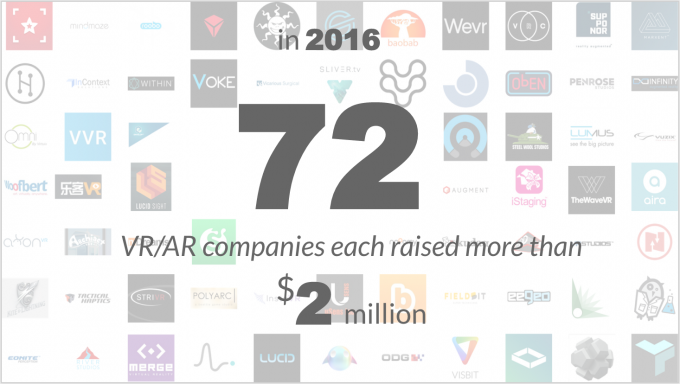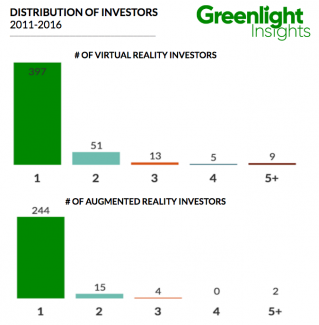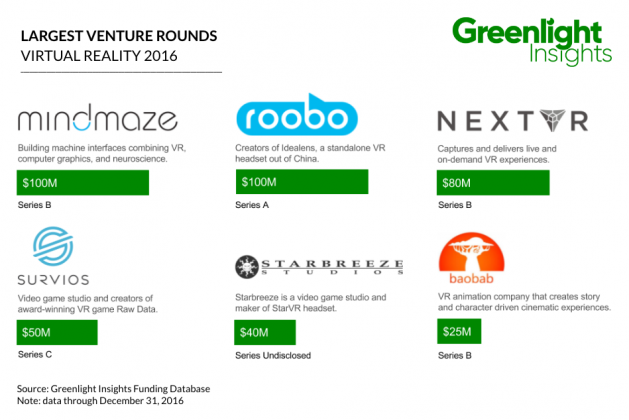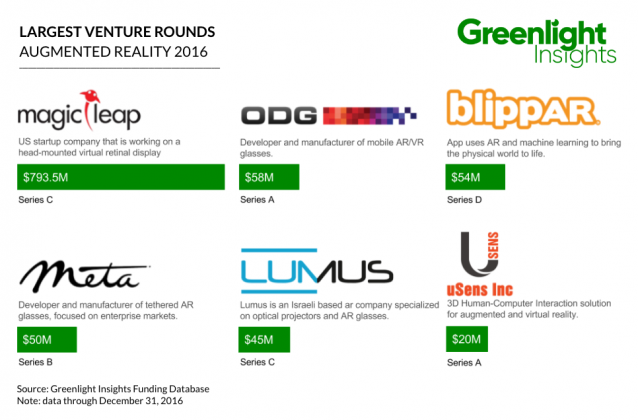With 2015 breaking previous records, industry observers entered 2016 wondering if VR/AR funding would be able to keep pace.
 Guest Article by Clifton Dawson
Guest Article by Clifton Dawson
Clifton is Founder & CEO of Greenlight Insights, a specialty market intelligence company focused exclusively on the VR and AR industries. Prior to Greenlight Insights, Clifton was a growth and monetization analyst at Snapchat, the leading image messaging and multimedia platform. Clifton has a B.A. in Economics from Harvard University and an M.B.A. from Harvard Business School.
Dollars and Deals
In 2016, venture funding of VR/AR companies reached $1.8 billion, ending significantly above 2015. Both median deal size and total number of deals in 2016 outpaced those in 2015, with a 58% increase in average deal size and 30% more deals, according to year-end analysis from Greenlight Insights of individual deals back to 2011.
 “In 2016, the increase in deal volume and median deals size illustrate a rapidly evolving landscape for VR technology”, said Clifton Dawson, CEO of Greenlight Insights.
“In 2016, the increase in deal volume and median deals size illustrate a rapidly evolving landscape for VR technology”, said Clifton Dawson, CEO of Greenlight Insights.
While total venture funding for VR/AR showed major gains in 2016, VR/AR still only holds 1% of total venture funding.
“Despite the category’s steady growth since 2011, compared to more mature industries, such as Transportation (9%) and FinTech (3.5%), VR/AR may not yet be mainstream enough for most investors,” said Ryan Rodenbaugh, an analyst with Greenlight that worked on the analysis.
In fact, throughout 2016, VR/AR deals were largely early stage, with more than 85% of all deals being Seed or Series A stage financings. Series C and later stage deals represented 7% of all deal volume, despite the top 6 VR deals of 2016 averaging nearly more than $65 million each, and the top 6 AR deals of 2016 averaging $170 million (the latter being skewed largely by Magic Leap’s massive Series C).
Nevertheless, there where many companies that closed a deal in 2015 that raised at least one more round in 2016. For example, NextVR and Blippar each closed deals in 2016, Series A and Series B respectively, and then Series B and C rounds in 2016.
Investors

VR/AR is benefiting from an increasingly diverse base of investors with widely varying investment theses, with many of the most active firms having done several co-investments. In 2016, the industry continued to see an increasing number of dabblers investing in VR/AR with 397 venture firms investing in one deal each this year. However, most Silicon Valley investors are not yet actively investing, with only 31 firms closing three or more deals since 2011.
Encouragingly, there is a growing list of notable investors committed to the space.
“The top of the most active investor list has remained remarkably stable over the 2015-2016 time period, with HTC, Intel, and Comcast amongst the most active corporate investors, and BoostVC and the Venture Reality Fund amongst the most active dedicated VR/AR funds,” said Dawson.
Looking Ahead to 2017
Over the last year, there has been a noticeable spike in investor interest in content producers as the industry realizes that for VR/AR products to really take off, consumers will soon demand need to have a significant amount of use for the hardware. Aided by huge recent investments in content production studios, funding in location-based VR, gaming and non-gaming entertainment, and live VR broadcasts, companies will attract a larger share of all venture capital dollars flowing to VR/AR. This trend reflects the growing importance of creating consumer-centric content to promote adoption and engagement with recently released devices.
As we look to 2017, Greenlight Insights is optimistic and excited about the growing role of virtual reality and the impact new technology companies will have on the B2C and B2B opportunities. Greenlight Insights and Road to VR will once again collaborate on the 2017 Virtual Reality Industry Report, a comprehensive overview of the industry landscape, due out this Spring.
Disclosure: Road to VR is a co-publisher of the 2016 Virtual Reality Industry Report, created in collaboration with Greenlight Insights.








